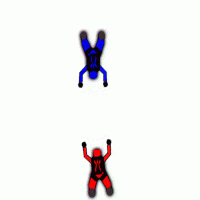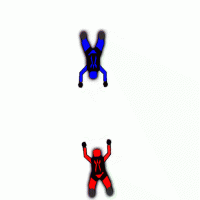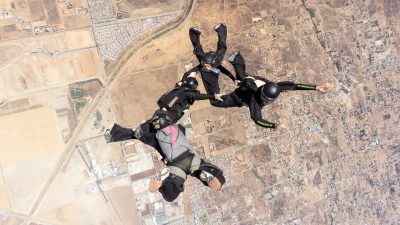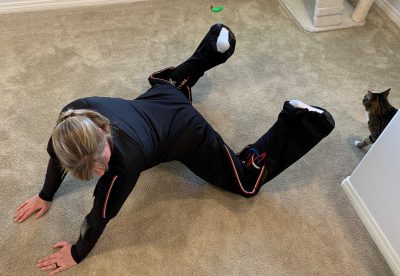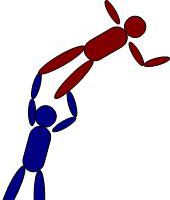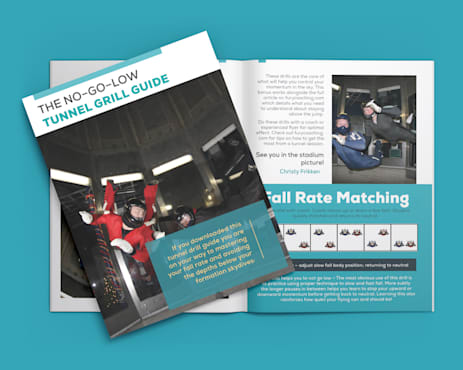Does Outfacing make you feel lonely? Master the basics now.
Monday, August 2, 2021

Does the thought of turning away from the middle terrify you? Do you drift away or sink out whenever you aren’t looking at the middle? Terrified about your position as point on a team? Here are the secrets to building phalanxes, bipoles, and more.
Out-what??
Outfacing is when a formation skydiver is in a part of the formation that is facing away from the center or other flyers. The green and blue figures in the picture below is executing outfacing.
You can outface on any sized formation. You can be outfaced from the center and still have other people in front of you, perhaps even gripping them, as is the case for the yellow color guy in this 8-way formation.
The opposite of outfacing is in-facing. In-facing is looking towards the center of the formation.
Fixing a boo-boo
Before I tell you how to ace outfacing like a pro, let’s talk about fixing a mess up.
Not in the exact right spot? Turn back in, fly to the formation, and try again. Crack your turn too soon? Undo your turn, look at it, fix your position, then try again. Sliding away? Stop, turn toward the formation, go to the right spot, and redo.
Not in the exact right spot? Turn back in, fly to the formation, and try again!
It is eye-poppingly tricky to fix issues while outfaced. I remember ending up out and low on an 8way spider once; I tried to do it the hard way. Two years as a tunnel instructor and thousands of competitive jumps did not ease the sense of panic as I struggled and failed to close the gap. I turned back in, flew right to it, and carried on.
Fun fact time! Outfacing used to be called “Backing-in.” This terminology has fallen out of favor because it misleads people into the incorrect technique. When appropriately done as described below, there is no backing up. Backing into a formation is a terrible, awful, and evil plan.
Secret Stuff
Now the exciting magic bits! To do this well, you should look, keep a good body position, keep your level, learn the right position, wait for the formation to be ready, and plan to stage builds. All easy stuff now that you know!
Always looking
When you turn out, continue to look at the formation and the portions you can see. Look through the whole turn and keep looking when you are away! If you peek into the big empty nothing for a second, it will be much more challenging to reacquire the correct visual picture. Without any image to reference, you will have level and position issues.
Different levels of flexibility allow other jumpers to see different amounts behind them. Even the most skilled jumper will not see everything 100%. An extremely flexible flyer might learn to see the inside grip of their right leg over their left shoulder. Still, even this skydiver will have limited vision much beyond the person immediately behind them.
The good news is that even if you are not super flexible or skilled, you will see something while outfaced. Even if it is just a teeny tiny little bit of a shoulder or helmet, you can draw enough information to infer levels and position.
Always watch the center. Do NOT look away—even a tiny bit.
Body Position
When you outface, you must maintain a good arch to see as much as you can. Jumpers will often attempt to spread their knees/legs to see through them more clearly. Spreading your knees flattens the body position and reduces the amount you can see. Instead, keep your knees at their normal distance and continue to arch your hips down properly with your chin high.
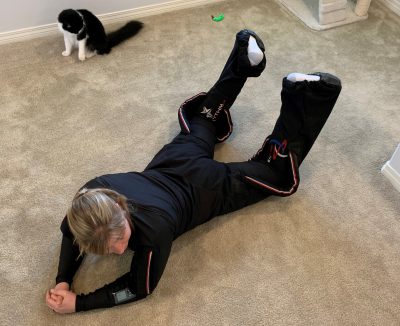
Look over your arm when you outface. Some jumpers look underneath their arm instead of over their arm to see more. Looking under was a classic technique but is no longer appropriate. It encourages a flat and de-arched body position, which reduces fall rate range.
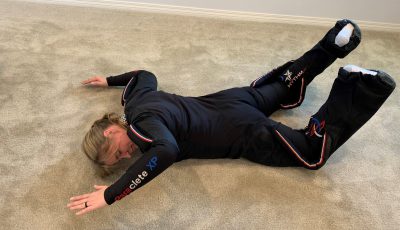
Keep your spine straight while you outface. Just like every other flying position, your spine should not bend or torque to the side.
A good body position is arched at the hips, with the hips low, chin high, and booties inflated. Some jumpers will attempt to see more by adopting a “checkmark” body position with their knees low and no arch. This upper body high body position causes the jumper to backslide and can make it difficult for others to pick up grips. To correct this problem, push your legs out a little while focusing on making your hips the lowest point of your body.
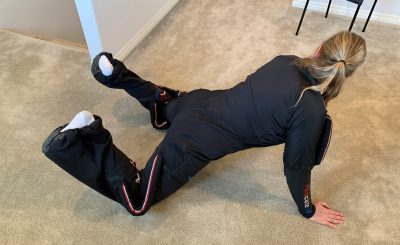
Levels
If you are looking, the next challenge will be to match the levels of the formation behind you. If you have adopted a good flying position with a stable arch, you might find it more difficult than usual to slow fall. Focus on using your arms and upper body to make adjustments.
Great outfacers match the fall rate before beginning outfacing. Matching first reduces the need to make adjustments once you are flying in the out position.
Jens demonstrating great level control while doing an outfacing drill
Position
To outface correctly, you must place yourself at the correct angle and the right distance from the formation.
Angle
The angle can be directly 180 from your target or cheated. Creep your dive first to determine the perfect angle. Those formations requiring a perfectly straight cat are commonly under-rotated, resulting in an incorrect shape.
The underlying issue is often trying to see too much. Remember, it is crucial to keep looking behind you, but you will have a reduced visual. Keep looking! See what you can see, but learn to be comfortable with a reduced picture. You only need a tiny bit of information about what is behind you to be successful.
|
|
Distance
Once jumpers learn the perfect angle, the next placement problem involves being too far away or too close to the person picking up the grips. Too far away usually stems from not looking at the target.
Being too close can be caused by several issues, including body position, incorrect mental picture, and lack of confidence in your place.
A bad body position can cause backsliding. Be sure you are arched, and you are not flying in the “checkmark” style.
Backing into a formation can be caused by an incorrect mental image of the position. The correct spot includes how far away you must be from the person taking grips. Do not place your leg grip behind the person’s head; expect them to reach forward for it correctly. Lots of creeping is especially helpful for this class of problems. Just be sure to have a trained eye creep with you – or an extra friend standing above to make sure you are at the correct angle.
Insecurity about not being picked up immediately is another reason people crash backward into a formation. When first starting to outface, it can be nerve-racking to fly out there “all by yourself.” Lonely flyers seeking reassurance leap to the conclusion they are too far away. They attempt to over-correct and end up shoving their knee at their partner. Fix this by turning in place, looking, and being confident you are in the right spot.
Slow down, Nitro!
Learning when to turn away is another large part of the outfacing skill set. The correct time to complete your move is when the formation is ready. If the relevant portion of the formation is not built, having a flyer dangling out in empty space will probably not speed up the process.
Ready is a more difficult concept to convey. Ready is on level, still, calm, and mentally prepared. It is easier to give counterexamples of a not ready formation. If, while in-faced, you see there are 4 feet of level difference between the center and opposite side of the formation, this is a terrible time to outface. If while in-faced the centers are distracted by someone on the other side brain-locking, this is a bad time to outface. If you see a wave coming through the formation (surf’s up!), this is a poor time to outface. In short, if the formation is sending out a formal invitation for you to turn away, don’t do it.
Staging
If you haven’t guessed, most flyers commit to outfacing too soon. In their rush to be a part of the formation or not be last, they are eager to complete their turn. By turning out too soon, they are making a moderately challenging maneuver an extremely challenging one. They increase the risk of a significant issue, slow things down, and distract the non-ready formation.
The bottom line is patience. Suppose you are still developing your judgment about what “ready” means, error firmly on the side of in-facing longer. Looking at it more will help you learn this skill faster and result in a much lower error rate.
Sometimes, particularly in competitive skydiving, flyers will attempt to skip the picture altogether and remain outfaced for two formations in a row. Going sooner is ok for highly predictable circumstances and with plenty of practice.
A trained 4-way or 8-way team will be ready sooner and sooner as they improve. With training, you can see this quickly and trust others to keep consistent levels and build stuff in the right place. However, many groups try and skip ahead to this step without laying the proper groundwork. You will score more points if you are patient and take the staging for a more extended period.
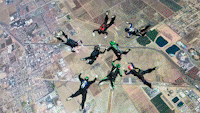
You can outface well! Just keep looking, keep arched, stay on level, learn the right angle and distance, wait for the right time, and plan to build in stages. And if you mess up, undo it by turning in, flying back, and resetting!
Tags: bodyflight, technique

